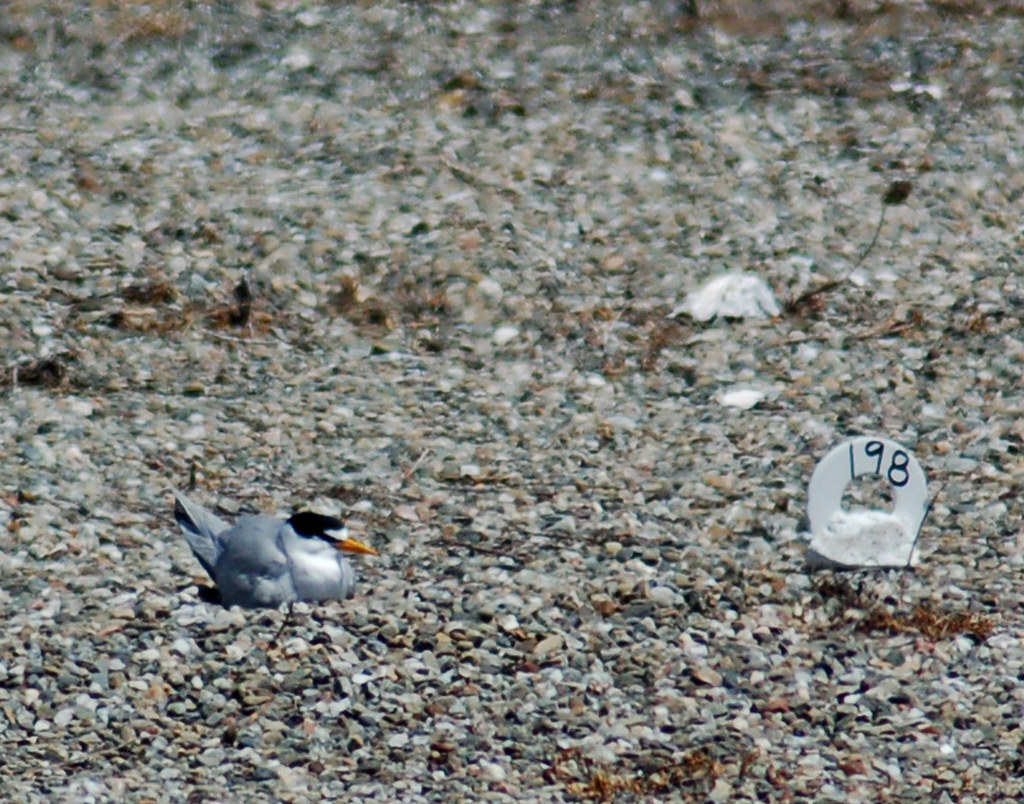One Good Tern Deserves Another

I've written, from time to time, about the sometimes uncomfortable intersection of people and animals. Today, Robb and I went on a bus trip to this very intersection.
I had been hearing murmurings about a proposed wildlife refuge on the decommissioned Naval Air Base on Alameda, but had never been able to figure out its whereabouts. As it happened, this was no accident. This site is closed to the public, except for a single day a year, when interested bird watchers are allowed to visit the breeding area for the Endangered Least Tern. When I found out about this, you just know that I jumped at this opportunity!
Fans of the television show Mythbusters will have a mental picture of the abandoned runways on this naval base. Now, picture this: In the middle of the runway, there are hundreds of tiny fragile birds, sitting on eggs. Since the 1960's -- when the base was still in use -- the Least Terns were using the runways as nesting sites. Can you imagine what it must have been like to try to raise a family as gigantic fighter jets rumbled across your home?

Least Terns are tiny -- the smallest of all gull-like birds. They weigh less than two ounces (that's less than half a stick of butter), but somehow migrate thousands of miles every year. They are also terribly endangered, so the fate of their home on the former naval airbase is hotly contested. As far as I can tell, the Navy is willing to hand the land over to the Department of Fish and Game, but only if that frees the Navy from any responsibility for cleaning up the toxic mess that seems to exist on so many military sites. The Veterans' Administration also has its eye on the land, as (no doubt) do many many real estate speculators. The property is huge -- hundreds of acres -- with a superlative view of the San Francisco Bay. It is also terribly unstable, being built on dredged-up seashells back in the 1930's. Apparently, the water table is so high, that it would be pretty much impossible to install any underground infrastructure. And goodness knows what would happen in the event of an earthquake, on such unstable ground.
At the moment, the Least Terns have a home smack-dab in the middle of the old runway. They live inside of a fenced enclosure that keeps terrestrial predators out, and baby terns in. (You can see the ghost of the fence in the photo of the Tern and its two fuzzy babies.) A small corps of dedicated volunteers monitor any predation on the tern colony. Although they aren't authorized to take any action against raptors, just the fact that they are nearby seems to deter hawks and falcons from chowing down on terns. They all agree that the act of raising a pair of binoculars or a camera is enough to spook most over-flying raptors. Who knew?
Today, Robb and I signed up to tour this unique parcel of private property. We boarded a big yellow school bus with the one person who oversees the Least Tern colony, and who works inside the locked gates. As the terns do not recognize a huge yellow bus as a predator, but are terribly spooked by humans, we were to stay inside of the bus at all times. Turns out that it is a good thing that Robb is no longer a schoolboy. The jouncing ride of the school bus was torture to his back, and after the trip his legs were like jelly. (It probably also doesn't help that Robb and his doctor had decided to take him off one of his medications, which is seems was doing more good than anyone realized.) The bus driver kept the motor running the whole time, because the ongoing noise of the engine is way less stressful for the birds than the sound of the bus ignition being tuned on. This made for some shaky photography.

Inside the fenced section of runway, the Least Terns lay eggs on the ground (like many shore-nesting birds, they don't build a nest at all), and raise their young. The volunteers have laid down gravel for the birds, as well as oyster shells and various other shade-making items. The little birds are "cryptically colored" so that they completely blend into the gravel. That's a good thing if you are a tiny helpless creature. For the last few years, about three hundred baby birds have successfully fledged from this single nesting site. This may not seem like a lot, but it represents ten percent of all the baby terns that fledge in the entire state of California. The care of this small fenced area may mean the difference between life and extinction for the Least Terns.
Seeing these tiny birds and their teeny-tiny fluffy babies was truly awesome! We are so lucky to share a home with them.

Comments